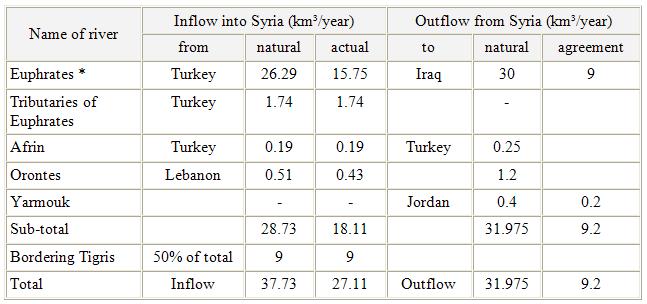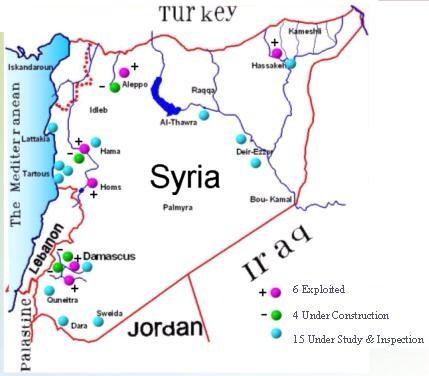1- General Background
* Geography and population
Syria, with a total area of 185180 km², is bordered in the north by Turkey, in the east and southeast by Iraq, in the south by Jordan, in the south-west by Israel and in the west by Lebanon and the Mediterranean sea. Administratively, the country is divided into 14 governorates, one of which being the capital Damascus. The country can be divided into 4 physiographic regions:
– The coastal region between the mountains and the sea;
– The mountains and the highlands extending from north to south parallel to the Mediterranean coast;
– The plains, or interior, located east of the highlands and including the plains of Damascus, Homs, Hama, Aleppo, Al-Hassakeh and Dara’a;
– The Badiah and the desert plains in the south-eastern part of the country, bordering Jordan and Iraq.
Syria has nearly a total population of about 18 million (2005) with a high growth rate of 3.1% per annum.
* Climate and water resources
– Climate
Syria’s climate is Mediterranean with continental influence: cool rainy winters and warm dry summers, with relatively short spring and autumn seasons. Large parts of Syria are exposed to high variability in daily temperature. The maximum difference in daily temperature can be as high as 32°C in the interior and about 13°C in the coastal region. Total annual precipitation ranges from 100 to 150 mm in the north-west, 150 to 200 mm from the south towards the central and east-central areas, 300 to 600 mm in the plains and along the foothills in the west, and 800 to 1000 mm along the coast, increasing to 1400 mm in the mountains. The Average annual rainfall in the country is 252 mm giving 46.6 km³.
– Water resources
There are 16 main rivers (6 are international rivers) and tributaries in the country. The natural average surface runoff to Syria from international rivers is estimated at 28.73 km³/year. Total natural average outflow from Syria is 31.975 km³/year, a breakdown of surface water entering, bordering and leaving the country is given in the Table 1.
Table 1 Major rivers entering, bordering and leaving Syria (FAO, 1997)

* Turkey has unilaterally promised to secure a minimum flow of 15.75 km³/year at its border with Syria.
Although figures for water resources are very difficult to obtain due to the lack of reliable data, it can be estimated that water resources generated from rain falling within the country amount to 7 km³/year. Groundwater recharge is about 4.2 km³/year, of which 2 km³/year discharges into rivers as spring water. Total groundwater inflow has been estimated at 1.35 km³/year, of which 1.2 km³ from Turkey and 0.15 km³ from Lebanon. Although not quantified, the amount of groundwater flowing into Jordan may be significant.
* Dams and lakes
There are about 141 dams in Syria with a total storage capacity of 15.8 km³. The largest dam is located at Al-Tabka on the Euphrates. It forms the Al-Assad lake with a storage capacity of 11.2 km³. Medium-sized dams include the Al-Rastan (225 million m³), the Mouhardeh (50 million m³) and the Taldo (15.5 million m³). There are some 20 dams classified as small, the largest of which is the Dara’a, with a storage capacity of 15 million m³. The majority of these dams are located near Homs and Hama. Apart from the Al-Assad lake, there are five lakes in Syria, the largest being lake Jabboul near Aleppo with a surface area of about 239 km². Lake Qattineh near Homs is the main perennial lake in Syria.
* Water withdrawal
Total annual water withdrawal in Syria in 1993 was estimated at 14.41 km³/year, of which agricultural use accounted for 94.4% (3.7% is withdrawn for domestic use and 1.9% for industrial use). The assessment of agricultural water use is based on the assumption that the maximum water requirement is about 13 450 m³/ha per year. The treatment of domestic wastewater is carried out mainly in the towns of Damascus, Aleppo, Homs and Salamieh. The total amount of treated wastewater was estimated at 0.37 km³/year in 1993, which represents 60% of the total produced volume of 0.61 km³/year. Figure 1 shows amounts of water uses in Syria.

Note: m. m³ (million cubic metre )
Fig. 1 Water uses in Syria , (Ali & Yasser 2004)
|
Contaminants
|
Raw Wastewater
|
Secondary Effluent
|
Tertiary Effluent
|
|
Temperature (C)
|
30-40
|
–
|
–
|
|
pH
|
6-8
|
6-8
|
6-8
|
|
Chemical oxygen demand COD
|
600-900
|
–
|
–
|
|
Biochemical oxygen demand BOD5
|
250-350 (*)
|
20-30
|
10
|
|
Total solids
|
1500-2000
|
300-500
|
100-200
|
|
Total suspended solids
|
200-300 (*)
|
20-30
|
10
|
|
Volatile suspended solids
|
150-250
|
–
|
–
|
|
Sulfate SO4
|
200-400
|
–
|
–
|
|
Sulfide
|
5-20
|
–
|
0
|
|
Grease / Oil
|
30-50
|
0
|
0
|
|
Residual chlorine
|
–
|
–
|
0.5-1
|
|
Ammonia (as N)
|
30-50
|
–
|
10-15
|
|
Disease
|
2000
|
20001
|
2002
|
2003
|
2004
|
|
Hepatitis/A
|
3576
|
4166
|
4050
|
2843
|
2929
|
|
Typhus
|
5101
|
5781
|
4777
|
4169
|
4747
|
|
Acute infectious Diarrhea
|
100146
|
121323
|
147765
|
158003
|
199556
|



|
Treatment plant type
|
Construction cost
per inhab.
|
Running cost
per inhab./a
|
Specific surface
m² per inhab.
|
|
Stabilization
ponds
|
1.785 SP/inhab.
29,74 Є/inhab.
|
192 SP/inhab. a
3,5 Є/inhab. a
|
1,6 m²/inhab.
|
|
Aerated
Lagoons
|
1.137 SP/inhab.
18,93 Є/inhab.
|
346 SP/inhab. a
5,7 Є/inhab. a
|
1 m²/inhab.
|
|
Conventional activated sludge
|
1.501 SP/inhab.
25,01 Є/inhab.
|
230 SP/inhab. a
3,84 Є/inhab. a
|
1 m²/inhab.
|
|
Extended
aeration
|
1.522 SP/inhab.
25,35 Є/inhab.
|
288 SP/inhab. a
4,8 Є/inhab. a
|
1 m²/inhab.
|
|
Stabilization
ponds*
|
429 SP/inhab.
7,15 Є/inhab.
|
25 SP/inhab. a
0,41 Є/inhab. a
|
2,1 m²/inhab.
|
|
Constructed Wetland
|
858 SP/inhab.
14,3 Є/inhab.
|
55 SP/inhab.
>1 Є/inhab.
|
0,5 m²/inhab.
|
|
Industry
|
BOD5
|
SS
|
F
|
COD
|
NO3
|
NO2
|
NH4
|
PO4
|
SO4
|
pH
|
T
|
|
|
Fertilizer
|
–
|
103
|
1.3
|
228
|
26
|
1.8
|
152
|
0.77
|
113
|
1615
|
7.8
|
33
|
|
Vegetable Oil
|
1875
|
650
|
–
|
4800
|
–
|
–
|
–
|
–
|
–
|
7400
|
12
|
33
|
|
Sugar Factory
|
1014
|
148
|
–
|
1970
|
–
|
–
|
–
|
–
|
–
|
1316
|
7
|
32
|
|
Dairy Products
|
2100
|
235
|
–
|
9000
|
–
|
–
|
–
|
–
|
–
|
3020
|
7.4
|
27
|
|
Dyeing&
Weaving
|
180
|
172
|
–
|
520
|
–
|
–
|
3.11
|
1
|
–
|
1570
|
11
|
22
|
|
Wool & Cotton
|
550
|
774
|
–
|
4080
|
–
|
–
|
–
|
–
|
–
|
2450
|
9.6
|
24
|
|
Wheels factory
|
105
|
65
|
–
|
154
|
–
|
–
|
7.6
|
5.4
|
–
|
900
|
7.9
|
21
|
|
Iron pipes Factory
|
120
|
196
|
–
|
1280
|
–
|
–
|
–
|
–
|
–
|
20450
|
2.4
|
–
|
|
Thermal Power Station
|
42
|
140
|
–
|
90
|
–
|
–
|
3.7
|
1.1
|
–
|
1400
|
7.1
|
30
|

